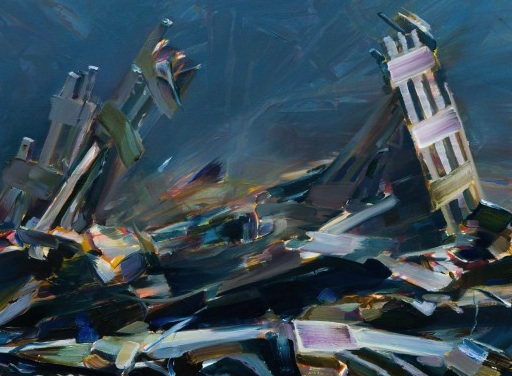Stylistic sea change
I wish I had the time and discretionary income to fly to Paris to see the new Duncan Wylie show at galirie dukan hourdequin. Instead, I’ll have to settle for the slide show at the gallery’s website. It may be a far cry from standing before the paintings, but the website offers a way to magnify the surface of the paintings by hovering your mouse over them and that goes a long way toward demonstrating how well Wylie paints. (Thanks to Harper’s for including one of these paintings in its current issue, which is how I found it. Over the years I’ve consistently discovered more interesting art from Harper’s than from nearly any publication actually devoted to the subject of art.) The new work is a tour de force of pure painting, technically gorgeous and masterful, framed by the semi-ironic context of its content, a series of apocalyptic images of disaster and collapse. It’s Franz Kline meets 9/11. Wylie appears to be working from photography of natural and human disasters, with images that hint at a tenacious struggle to survive in the aftermath. The brushwork is incredibly bold and confident, and his handling of value and hue accentuate the AbEx look of spontaneity while also, paradoxically, increasing the sense of depth and three-dimensionality in these scenes of ruin. Often using blues and grays, or other combinations, to hint at duotone photography, Wylie fades the backgrounds into a narrow middle range of values, achieving a sense of haze, distance, as well as hinting at the tension between immediate disorder and memories of whatever violence created it. In some cases, he appears to paint the background and then, on the dry surface, conjures a demolished structure with a transparent layer, so that the forms and lines bleed through the walls of the building in the foreground, giving it an eerie flesh-like translucency. Wylie’s sense of color is incredibly subtle and effective. His brushwork merges subject and style—the energy and seeming abandon of his paint application, as he unifies his image–and it both mirrors and works as a counterpoint to the explosive events that appear to have taken the world apart. His titles seem to have a cloying sense of sardonic amusement over the sense of tragedy he’s conveying—Afterparty, Yes, Love All—but it’s the only off-key note in the show. It’s hard to imagine work that offers a better fusion of representation and abstraction. Wylie’s style adopts the ragged structures of decay and collapse to accentuate paint’s ability to physically convey life, energy, and a fresh vision of the world.

Comments are currently closed.